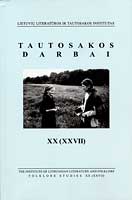Psichoakustiniai darnos rekonstravimo metodai
Psychoacoustical approaches od reconstruction of scales
Author(s): Rytis AmbrazevičiusSubject(s): Customs / Folklore
Published by: Lietuvių literatūros ir tautosakos institutas
Keywords: Psychoacoustic; traditional music; singing; tuning; anhemitonics; y-intonation; cents; transcription; traditional instruments
Summary/Abstract: Different aspects of scale recognition and reconstruction from acoustical measurements are discussed. The process of reconstruction of scale starts from pitch measurements that are complicated because of intrasonic and intersonic pitch changes (changes inside intonation of a separate sound and pitch differences between repeatedly intoned scale steps). Integral pitch of a separate sound is evaluated from intrasonic pitch contour or from spectrum. Pitches of an accord are determined from spectrum. Different ways of the corresponding procedures are overviewed. The objectivized scale structure follows from pitch histograms or LTAS. Nevertheless, the main point of the present paper is not merely acoustical objectivizing of scale, but rather the psychoacoustical reconstruction of scale from the data of acoustical measurements. That is to say, the insight into the rules of the original emic classification of pitches is the most important. This is demonstrated by several samples of Lithuanian traditional music. The principle of the “squeezed” anhemitonics is obtained to be prevailing in the scaling of sutartinės (vocal polyphony based on accords of seconds). That is, the scaling is approximately equidistant, with an average interval between neighboring steps slightly less than whole tone, roughly 180 cents. The same principle is characteristic of the tunings of skudučiai (multi-pipe whistles) and ragai (wooden horns), although other interpretations basing on two or three classes of intervals (instead of one) are theoretically possible as well. One could not offer more defined conclusion on tuning of these instruments because of very few recordings of the authentic performances. Scaling of sutartinės, skudučiai and ragai represent the case of quasi-stable sound system, i.e. the average pitches do not change in the course of performance. However, the simple psychoacoustical interpretation of LTAS or pitch histograms does not work in the case of unstable sound system characteristic of vocal solo performance. Position of the reference tone (e.g. tonal center) slightly fluctuates in this case resulting mostly in continuous rise of the absolute position of scale in the course of performance. Therefore an additional mathematical-statistical modeling eliminating the factor of the microtransposition is needed. After the corresponding recalculation of pitches from absolute to relative values the standard method of pitch histograms can be applied for the reconstruction of scale. Two samples of scale reconstruction in the case of unstable sound system are demonstrated. The first one reveals the same principle of the standard “squeezed” anhemitonics whereas the second one is the particular case of the “squeezed” anhemitonics: the mean intervals of the basic trichord widen from 157 cents in the first melostrophe to 183 cents in the last (24th) melostrophe. So this is the sample of so-called outspreading scales.
Journal: Tautosakos darbai
- Issue Year: 2004
- Issue No: 27
- Page Range: 102-116
- Page Count: 15
- Language: Lithuanian

